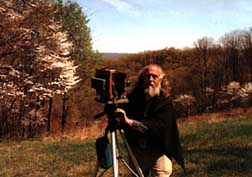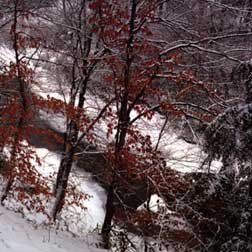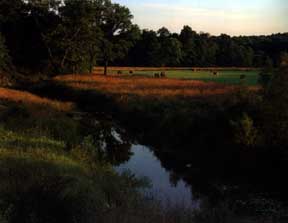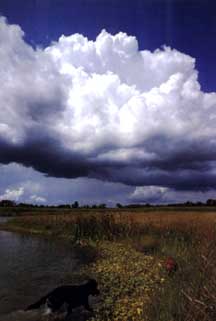|
|
 Darryl Jones Darryl Jones
Since moving to Owen County, Darryl Jones only needs to step outside his door to be surrounded by the beauty of Southern Indiana. But he goes beyond this and captures on film the essence of Indiana’s heritage, as well as images from around the world. I first became familiar with the photography of Darryl Jones after discovering The Spirit of the Place: Indiana Hill Country at the local library. This book was done with his long-time friend and fellow Owen County resident, author James Alexander Thom. Together they created a book of such quiet, yet enthralling beauty, that after taking the book home, I didn’t put it away until I had read and enjoyed every page of text and every photograph it contained. Since then, I’ve recognized Darryl Jones’ photography in several books on Indiana, and was interested in learning more about this native Hoosier. I spoke with Jones at his parent’s home in Indianapolis, where he provided a look at his background, and his work. Jones grew up in Fort Wayne, and after finishing high school, traveled to Denmark and Norway. He spent a year traveling in Europe and photographing mostly people - “people on the street, working in the fields, farmers and blacksmiths who I met”. When he returned to the United States, he went to Indiana University and earned a B.A. in Psychology, and studied Comparative Religions and Near Eastern Languages. Since 1975, Jones has been doing photography professionally on a free-lance basis. He has done exhibitions in Indiana, as well as New York, Boston, Chicago, and Cleveland. His works have also been published in books and calenders, and he has sold prints of his work. After his travels in Europe, Jones returned to his home state of Indiana. From that point on, he began doing more landscape photographs, and had the opportunity to do a book on Indiana. “My first book came out in 1981. From that time until now, my whole concentration has been here in Indiana.” His first book, called Indianapolis, was done with the Indiana Historical Society. In this book he documented the city as it was at that time, and his photographs were then contrasted with the city of the past.
The book was a success, selling at least 100,000 copies, and was in bookstores for 12 years, from 1984 to 1996. It can still be seen proudly displayed by Hoosiers throughout the state as a testimony to the beauty and diversity of Indiana. In 1996, when Indiana went out of print, it was replaced by Indiana, Volume II. McCormick’s Creek State Park, in Owen County, was featured on the cover. This book was also authored by James Alexander Thom. In this book Jones tried to incorporate landscape, architecture, and events such as the Hilly Hundred in Monroe and Brown Counties, Conner Prairie, and the Indianapolis 500. During the interview, as Jones flips through pages, he stops and points out a beautiful landscape of yellow flowers and says, “Now this happens to be our 40-acre flat field, and one spring all these mustard plants just grew naturally.” “In a sense, what I’ve been trying to do is convey to Hoosiers, and then to other people who are coming to the state, why I think Indiana is a beautiful state and what it has to offer. I think there’s an inherent beauty in the landscape.” He asks himself, “How would I convey this to somebody from another country? If the only thing they’ll know about Indiana is from the photographs I take of it, will they look at that book and come away with a sense of what I think is the natural beauty of the state? I really want to convey something of importance here.” A second Indianapolis was published in 1990, which featured cityscapes, architecture, people and events, and has also been well-known throughout the state. In 1987 he worked on the Pan Am Games book, titled The Games of August, in which he worked in 360 degree panoramic images. He explained that to get this effect he used an “old camera that turns on a tripod and has a round gear on the bottom” as well as inside the camera. The camera and film turn at the same time, pulling the film across the camera - in the end you have a film and a print that’s 10 inches by 72 inches - or a six foot print.
In 1995 and 1996 Focus on Sweet Owen was done for the Owen County Preservations, which featured all the historical buildings in his home county. In 1998 Jones participated in a book called Images of Religions and Culture for the Polish Center in Indianapolis, in which he surveyed the Eastern Orthodox Christian Church in Indianapolis. Other photographers represented Catholic and Protestant churches, and the Islamic mosque and Jewish synagogues. This project involved six photographers and 30 authors. As mentioned before, The Spirit of the Place; Indiana Hill Country was the first of Darryl Jones’ books to draw me in - especially since it seemed to focus attention on Owen County, where my husband and I live. This book was written by James Alexander Thom, also of Owen County. Jones and Thom met within a month after Jones and his family moved to Owen County, and the two soon became good friends. “After several years I had a body of photographs together, and we got together and said, ‘Let’s do something with this.’ Then of course it was a matter for James Thom to write something.” “What he (Thom) liked about this was this gave him a chance to write something about his life and his own experiences living in this county - living in the beauties of Southern Indiana. Whereas, his other books, generally are historical fiction, so he’s writing about a historical character. Here, he said, he could put things in this book that he could never put in print in any other book because these are personal anecdotes. He and I picked out the photographs, and then he often would use those photographs to reflect upon his life in Owen. He did not specifically write a caption to any of these photographs, but rather, the photograph was like a catalyst. The book is a personal statement from each person.” It is apparent not only in listening to Jones, but also in seeing his work, that he views his home state with reverence and appreciation; particularly the space into which he has settled with his family. After Jones and his wife Nancy had lived in Indianapolis for 15 years, they began hoping to move into the country with their two children, Aaron and Hannah. “Our children were growing up. My son was in the 9th grade, and my daughter was going into 6th grade, and we were really hoping to move from the big city out to the country so for some part of their lives we could be a family out in the country. So we began to look. When we saw the rolling hills and the countryside, we thought this was where we wanted to stay.”
Jones’ appreciation for Indiana is genuine and inspiring. “Here in Indiana we don’t have the oceans. We don’t have the mountains. But we do have beautiful clouds! Too many Hoosiers do have the sense that there’s no natural beauty here, so we always have to travel somewhere else to see it, and my point of view is, no, the beauty is here. The Indiana countryside doesn’t have the vertical peaks and mountains, or the dramatic waterfalls or oceans or waves. But you can stand in a field and watch the wind move the corn. And that’s beautiful. You watch grass in a field before it’s cut up for bales of hay - the wind blows that grass in all different patterns, and that’s a beautiful thing to see in and of itself." Darryl Jones’ photography can currently be seen in three separate exhibits in Indianapolis. A collection at William Engle Gallery on East 65th Street in Broad Ripple contains several Owen County subjects, and include his manipulated photographs, taken with Polaroids but having the colors manipulated to resemble paintings. His collection at the Christian Theological Seminary Library focuses on the “Faces of Islam” collection he photographed while in Egypt, Saudi Arabia, Turkey and England. And the third collection at the St. Seraphim Bookstore of the Joy of All Who Sorrow Orthodox Christian Church at 1516 N. Delaware, focuses on this church. His Year 2000 Calender is also available at Border’s and Barnes and Noble Book Stores. Highlighted books may be ordered from |
|
©1999 Southernin.com |
|
 At the same time, Jones heard that a publishing company in Oregon was planning to do a book on Indiana. The editor suggested he submit his work. He was chosen as the photographer for this book, to be called simply, Indiana, and in 1980 Jones began working on it. “This was 1980 and the book was to come out in 1984. So...this was a real challenge. I tried to be balanced, from Amish homes, to Southern small towns like Oldenberg... to horse riding events like Trader’s Point, Wilbur Wright’s home... I worked really hard on it, and at the same time, there were no guarantees.” Since he would be paid by commission based on the book’s sales, he worked for almost four years without any income from his endeavor. “So I really had to want to photograph these sites and have an interest in it!”
At the same time, Jones heard that a publishing company in Oregon was planning to do a book on Indiana. The editor suggested he submit his work. He was chosen as the photographer for this book, to be called simply, Indiana, and in 1980 Jones began working on it. “This was 1980 and the book was to come out in 1984. So...this was a real challenge. I tried to be balanced, from Amish homes, to Southern small towns like Oldenberg... to horse riding events like Trader’s Point, Wilbur Wright’s home... I worked really hard on it, and at the same time, there were no guarantees.” Since he would be paid by commission based on the book’s sales, he worked for almost four years without any income from his endeavor. “So I really had to want to photograph these sites and have an interest in it!” He also worked on a book with the Indiana Historical Society called
He also worked on a book with the Indiana Historical Society called  Darryl Jones’ work portrays a sense of harmony that has probably grown from the spiritual perspective from which he sees nature. “Every tree and species, every animal has its place, and it’s all a reflection of divine beauty, order, harmony, and it’s to be understood... It’s possible to see in creation, you could say, the original divine intent.”
Darryl Jones’ work portrays a sense of harmony that has probably grown from the spiritual perspective from which he sees nature. “Every tree and species, every animal has its place, and it’s all a reflection of divine beauty, order, harmony, and it’s to be understood... It’s possible to see in creation, you could say, the original divine intent.”